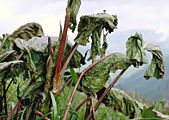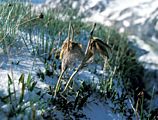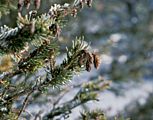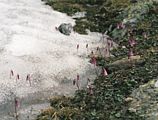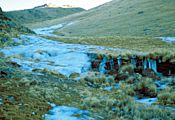Low temperature extremes
The altitudinal distribution of taxa reflects their tolerance to low temperature extremes. Alpine plant taxa will not be killed by freezing temperatures, but may suffer partial tissue losses at times.
Mechanisms of freezing resistance in plants
Plants may escape exposure to critically low temperatures by selecting certain habitats, using certain phenology or by specific morphology.
-
Escape by habitat selection
Plants which cannot tolerate freezing are forced into habitats with secure winter snow cover (typical snow bed plants).
-
Escape by phenology
The withdrawal of sensitive tissue from exposed positions during critical periods, is another form of escape. In its extreme form, it is the survival as seed as in the annual life form. Annual plants are very rare in temperate zone mountains, but are regularly found in mediterranean and subtropical mountains.
-
Escape by specific morphology
Plants can position their sensitive meristems below ground permanently (see illustration on the right).

